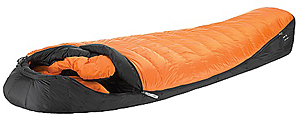Some people just sleep warmer than others. They are the ones who climb into their bag with barely a stitch on, neglect to zip themselves completely closed or cinch down that hood, and then fall thoroughly asleep until dawn.
If you’re not one of these lucky ones, but instead find yourself shivering and wondering how much longer till morning, there are certain things you can do as a cold sleeper to gain some extra warmth and get a good night’s sleep.

-
Use a mummy bag with the right temperature rating. Mummy bags are the warmest options available since they have the least space for your body to heat up. Make sure yours has an insulated draft tube along the zipper, an insulated draft collar around your neck, and a well-insulated hood you can cinch down. Choose a sleeping bag with a temperature rating that is at least as low as the coldest temperature you expect to encounter ever. Then adjust downward at least another 5 to 10 degrees.
-
Female? Consider a women-specific bag. Women-specific sleeping bags are sized and insulated for women’s slower metabolisms and unique body shape. These bags are shorter, wider at the hips, narrower at the shoulders, and have more insulation in the toe box and torso areas to offset heat loss. This means less extra space to heat up and warmer nights.
-
Add a liner or overbag. A sleeping bag liner will add a few degrees to your bag’s temperature rating without you having to buy a whole new bag for slightly colder nights. An overbag, which fits over your current sleeping bag, can add 10, 20, even 30 degrees to your bag’s temperature rating.
-
Keep your sleeping bag dry. Wet sleeping bags are poor insulators and in the case of down are practically useless. If you don’t think you can keep your bag dry—due to the conditions you’ll be encountering or your own clumsiness—get a synthetic bag, which will retain much of its insulating power if it does get wet.
-
Sleep in a tent or bivy sack. Tents and bivy sacks can add 5 to 10 degrees of warmth compared to the outside temperature. Pitch your tent in a sheltered (non-windy) spot to maximize this temperature gain. Even warmer in winter is a snow cave, provided you know how to build one safely.
-
Use a ground pad. All temperature ratings of sleeping bags assume the use of a good quality sleeping pad year round. In winter conditions this means a full-length pad (or two). Sleeping pads insulate you from the cold ground and help reduce heat loss. Closed-cell foam and self-inflating pads are your best bet. In a pinch you can also put a pack or extra clothes under your bag for more ground insulation.
-
Shake out your bag and give it a good fluffing as soon as you set up camp. This will give it time to fully loft back up before you go to sleep.
-
Eat. You may not be able to change your personal metabolism, but you can give it a jump-start. Properly fuel your body with nutritious foods and plenty of water during the day. Then eat some long-burning carbs and high protein snacks (like peanut butter) just before bedtime.
-
Drink. Staying hydrated helps your body generate heat and therefore keeps you from getting cold. Have a hot drink before bedtime. No alcohol though, which will ultimately lower your core temperature.
-
Move around. You can also stoke your inner furnace by moving around briskly just before bedtime. This will get your blood flowing and warm not only your core, but your extremities too. Just don’t overdo it and get sweaty. Make sure you're dry before crawling inside.
-
Wear warm, dry clothes. No, sleeping naked does not keep you warmer than sleeping clothed, despite what your tent mate may have told you. Wear warm, dry clothes (not the long underwear and socks that are still damp from your day’s exertions). Cotton retains moisture, so avoid it entirely. Make sure you have enough on, but not too much bulk, which will compress your clothes and bag and diminish their insulation. Too many tight layers can also constrict your blood flow so don’t put on layer upon layer of socks. Warm, dry base layers and a beanie style hat will make a world of difference in retaining heat.
-
Eliminate extra space. Have extra space at the foot of your sleeping bag? Fill it up with your clothes for the next morning. You’ll eliminate the cold air pocket at your feet, and your clothes will be warm in the morning.
-
Sleep with a bottle of hot water. A hot water bottle (one you’re sure is very securely closed) will feel nice and cozy at the foot of your sleeping bag. It can also do double duty as a hot drink before bed.
With these tips at the ready you can actually look forward to a long, restful, warm night’s sleep on your next overnight.

 by Alicia MacLeay
by Alicia MacLeay









